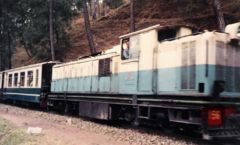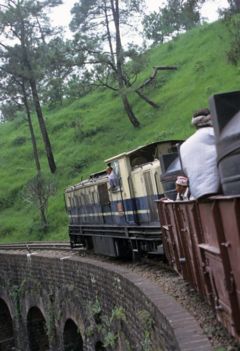Kalka-Shimla Railway
The Kalka-Shimla Railway is a 2 ft 6 in (762 mm) narrow gauge railway in North-West India travelling along a mostly mountainous route from Kalka to Shimla.
History
Shimla was discovered by the British shortly after the first Anglo-Gurkha war. By 1830s, Shimla had already developed as a major base for the British. It became the Summer Capital of British India in 1864.
Bhalkoo, the "illiterate genius" had played a vital role in the construction of the Kalka-Shimla rail line. The contract for construction was awarded to the Delhi-Umbala Company in 1898 at an estimated cost of Rs 86,78,500, however, the cost doubled during execution of the project and it was finally purchased by the state in 1906 for Rs 1,71,07,748. The 96.54 kilometre line was opened for traffic November 9 1903. Because of the high capital and maintenance cost, coupled with peculiar working conditions, the Kalka - Shimla Railway was allowed to charge fares that were higher than the prevailing tariffs on other lines. However, even this was not good enough to sustain the company and the Government had to purchase it on January 1 1906.
Route
The Kalka-Shimla Railway was built to connect Shimla, the summer capital of India during the British Raj, with the Indian rail system. Now, Shimla is the capital city of Himachal Pradesh and Kalka is a town in the Panchkula district of Haryana. Spectacular scenery along the whole route, and the marvels of its construction, keeps the traveler on this line spell bound. On leaving Kalka, 656 metres above sea level, the railway enters the foothills and immediately commences its climb.
Stations
The route offers a panoramic feast of the picturesque Himalayas from the shivalik foot hills at Kalka to several important points such as Dharampur, Solan, Kandaghat, Taradevi, Barog, Salogra, Summerhill and Shimla at an altitude of 2076 metres.
Engineering
The Kalka Shimla Railway runs through 102 tunnels. The longest tunnel is at Barog, and is named after the engineer in charge of construction. Mr Barog apparently committed suicide after making a mistake in laying the alignment. This tunnel is 1143.61 metres long and remained for a long time the second longest tunnel on the Indian Railways. It is a straight tunnel, passing through fissured sandstone.
The line has 864 bridges, one of which is a 60 feet plate girder span and steel truss. The others are viaducts with multi-arched galleries like the ancient Roman aqueducts. Bridge No. 493, historically known as the "Arch Gallery", situated between Kandaghat and Kanoh stations, is an arch bridge in three stages, constructed with stone masonry. Bridge No. 226; between Sonwara and Dharampur is an arch gallery bridge having 5 tier galleries of multiple spans, constructed with stone masonry and bridging a deep valley surrounded by high peaks.
The railway has a ruling gradient of 1 in 25 or 4%. It has 919 curves, the sharpest being 48 degrees (a radius of 123 feet). Climbing from 656 metres, the line terminates at an elevation of 2076 metres at Shimla.
Locomotives
The first locomotives to arrive were two class "B" 0-4-0ST from the famous Darjeeling Himalayan Railway. These were built as 2' gauge engines, but were converted to 2' 6" gauge in 1901. They were not large enough for the job, and were sold on in 1908. They were followed by 10 engines with a 0-4-2T wheel arrangement of a slightly larger design, introduced in 1902. These locos weighed 21.5 tons, and had 30" driving wheels, and 12"x16" cylinders. They were later classified into the "B" class by the North Western State Railways. All these locos were constructed by the British firm of Sharp Stewart.
Larger locomotives were introduced in the form of an 2-6-2T, of which 30 were built with slight variations between 1904 and 1910. Built by the Hunslet and the North British Locomotive Company, these locomotives were about 35 tons, with 30" drivers and 14"x16" cylinders. These locomotives, later classed K and K2 by the North Western State Railways, subsequently handled the bulk of the railways traffic during the steam era. A pair of Kitson-Meyer 2-6-2+2-6-2 articulated locomotives, classed TD, were supplied in 1928. They quickly fell into disfavour, as it often took all day for enough freight to be assembled to justify operating a goods train hauled by one of these locos. Shippers looking for a faster service started to turn to road transport. These 68 ton locomotives were soon transferred to the Kangra Valley Railway, and subsequently ended up converted to metre gauge in Pakistan.
References
- Hughes, H., (1994) Indian Locomotives Part 3, Narrow Gauge, 1863-1940. The Continental Railway Circle, Harrow, UK. ISBN 0-9521655-0-3
External links
- http://hill-stations-india.com/hill-trains-india/kalka-shimla-railway.html
- http://www.luxury-train-travel-tours-india.com/hill-trains-in-india/kalka-shimla-railway.html
- http://www.tribuneindia.com/2003/20031104/himachal.htm#1
- http://www.shimla-travel.com/shimla_railway.shtml
- http://www.indianadventureportal.com/trains/kalka-shimla-toy-train.html
- http://www.outlooktraveller.com/aspscripts/mag_art.asp?magid=214&page=1
- http://www.pearcedale.com/c&b/DL.html#indi
- http://mikes.railhistory.railfan.net/r019.html
- Article in The Tribune
- Article on Kalka Shimla Rail


